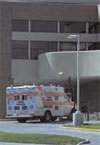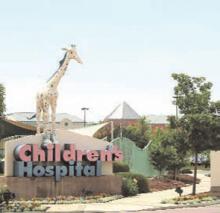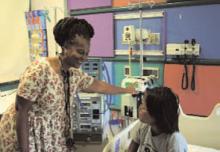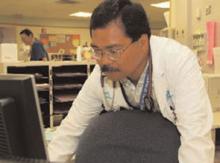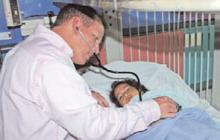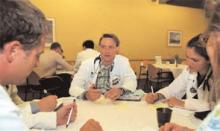User login
Children’s Hospital of Central California (CHCC), Madera, Calif., cuts a wide swath through its 45,000-square-mile catchment area, which overflows with 1 million children. Eight miles northwest of Fresno, it nestles in a wheat field, part of the San Joaquin Valley’s 1.88 million acres of rich farmland that contributes $4 billion annually to California’s economy. Fresno is home to a population that is 60% minority; the city is a multicultural mélange of Hispanics, blacks, and Asians with dozens of languages and homelands.
—Todd Suntrapak
CHCC’s challenge is to continue to attract privately insured patients, who account for 30% of its clients and choose the hospital for its clinical excellence, while serving a 70% majority of publicly insured and uninsured migrant and poor urban families. Even with public payers, national statistics starkly highlight CHCC’s reimbursement quandary: Healthcare expenditures for uninsured and publicly insured immigrants are approximately half those of their U.S.-born counterparts, while immigrant children account for 74% lower per capita expenditures than U.S.-born children.1
CHCC’s patients are treated in an architecturally dramatic hospital organized around an “Our Universe” theme. Bright colors splash everywhere, its low-profile buildings don’t scare children, and cozy lounges and other homey touches are welcoming.
CHCC is organized into four 32-bed “starships.” Starship Discovery covers gastroenterology and infectious diseases, while Starship Apollo’s passengers get 24-hour supervision of cystic fibrosis, bronchitis, syncytial virus, and sleep apnea. In Starship Explorer, hospitalists tend to about 10,000 postoperative patients annually, with cardiovascular, neuro, and orthopedic procedures predominating. Starship Craycroft is dedicated to hematology, oncology, diabetes, and nephrology, as well as clinical trials for cancer, sickle cell anemia, and hemophilia. Hospitalists move readily from one starship to another, rather than being assigned to a service.
Rocky Start
The hospitalists, members of Children’s Hospital Medical Group (an 80-doctor multi-specialty group) are now integral to CCHC, but the program started shakily. According to Don Fields, DO, and chairman of the hospital medicine group, administrators approached him and another physician in 1998, asking them to establish a hospitalist service in anticipation of relocating from Fresno to the new hospital. Moving from a busy downtown location convenient to doctors’ offices to a hospital in rural Madera required more driving for office-based physicians making hospital rounds. Geography and huge practice loads in a medically underserved area created the need for a hospital medicine group.
The physicians, naïve to the challenges, agreed to start a service. “When the program started it wasn’t busy because the attending physicians didn’t have a concept of who hospitalists were and what we did,” recalls Dr. Fields. “We had few patients and were worried we’d be fired because of lack of interest.”
After the hospital’s chief medical officer spread the word to community physicians, doctors started referring in droves. “The community [doctors] realized they didn’t have to take night calls or leave their busy offices to make hospital rounds,” adds Dr. Fields.
A recent feather in CHCC’s cap is Kaiser-Permanente of Fresno’s decision to contract for the hospital medicine group’s services. Alice Calhoun, MD, and CHCC’s hospital medicine group’s co-director, says that “the Kaiser staffers, administrators and clinicians, are total sticklers about outcomes and efficiency, and this recent decision speaks to our reputation and competence.”
Dr. Calhoun joined the hospitalist group early on. Having practiced pediatric emergency medicine for eight years in Wisconsin, she interviewed for a similar position at CHCC but chose the nascent hospitalist program instead. “It was a very large hospital, and I saw huge growth potential for hospitalists,” she says. “There weren’t many rules, and I knew we’d create a niche for ourselves.”
Ralph Diaz, MD, joined the group in 2000. Two years later, he became Children’s Hospital Medical Group’s medical director, dealing with quality issues, patient safety, and revenue enhancement. He even mediates disputes between doctors for the 80-person multi-specialty group. Despite a dual workload as hospitalist and administrator, Dr. Diaz loves his job. “It’s what gets me up in the morning,” he says. “The acuity of illness of the children we treat and the fact that we see everyone—from a yuppie family in one room … to migrant farm workers in another—is exciting.”
Paramount Efficiency
CHCC’s hospitalist program isn’t an admitting service for community physicians’ convenience. It deals with very sick children, lean and mean reimbursement, $20 million annually in uncompensated care, and little to no financial margin of error. With 70% of its patients funded by Medi-Cal and others uninsured, the hospitalist program, says Todd Suntrapak, the hospital’s COO, needs to be lean and efficient and must retain stellar doctors. “Our population is medically underserved, reimbursements don’t always cover our costs, and we deliver millions of dollars of uncompensated care,” says Suntrapak. “Our hospitalists continue to elevate the quality of care with clinical pathways for over 25 conditions and are constantly improving efficiency.”
Bill Fletcher, CHCC’s director of outcomes and research, has the numbers to support hospitalist efficiency. He explains that hospitalists’ contribution margin, the amount their service line contributes toward overhead, exceeds $500 per patient. With 12,000 inpatients a year, a ballpark estimate of the hospitalists’ contribution if they only saw 60% of them would be $3.6 million, although Fletcher wouldn’t confirm specifics.
“The hospitalists’ contribution is golden. Unlike cardiac surgery, whose high costs could never generate such [a] margin, the hospitalists create enormous value for us,” says Fletcher.
A key efficiency component is compliance with clinical pathways. Fletcher tracks CHCC’s performance against national standards (www.leap froggroup.org) and with its own pathways. “We don’t measure our hospitalists’ performance a lot because they’re so integrated into the hospital,” he says. “But we look at compliance with our 25 clinical pathways [by examining] each case, by [looking at] diagnosis, and [by making sure] it fits the pathway.”
Here’s how the hospitalists stacked up:
Suntrapak reckons the process works. “Our hospitalists are giving excellent, efficient care—particularly with high-volume diagnoses such as asthma, appendectomy, and bronchiolitis,” he notes. With regard to adherence to pathways, Dr. Calhoun says, “If we worked in a vacuum, I wouldn’t like that kind of tracking, but we realize how much is saved by using them.”
In addition to hospitalists standardizing treatment for 25 conditions as a way to promote efficiency, the physicians find that pathways and standing orders free nurses by clearly delineating clinical responsibilities. “Pathways allow nurses to do what they’re trained and authorized to do. By spelling this out clearly, the pathways have cut our pager calls by 50 percent,” notes Dr. Calhoun.
On a systemic level, hospitalists contribute by analyzing data and then recommending ways in which CHCC’s precious resources can be allocated most effectively. For example, this year hospitalists are serving on four bed management subcommittees dedicated to streamlining patient throughput, attempting to flatten barriers to moving kids efficiently from the emergency department (ED) to general floors or ICU and through discharge. Dr. Calhoun’s work group is penning criteria for prioritizing the list of potential recipients of CHCC’s next scarce available bed—will it be a small community hospital, a doctor’s office, or a tertiary care hospital?
Scheduling, a Pleasant Surprise
The hospitalists work a 12-hour block schedule, with seven days on and seven days off, but Dr. Fields says “it works for us because it feels like we have the luxury of a lot of time off.” The doctors are good friends, going scuba diving, traveling, and camping together, and their kids have playdates. Dr. Fields admits that doctors near burnout in the hectic winter months when census climbs, but the friendships among colleagues pull them through. “If someone’s mother is dying, or their children are sick, they know that they’re covered because we’re friends,” he says.
Paul Parker, MD, a group member who commutes from San Diego, does the scheduling three months in advance so that the physicians can plan their lives. All hospitalists have one vacation request guaranteed, and holiday coverage is distributed equitably.
Dr. Diaz points to the positive effect of one unusual twist—starting rotations on Friday. “You learn about patients from your colleagues before the weekend, knowing that major procedures won’t happen until Monday,” he says. “It promotes efficiency, because you can discharge patients on Friday without discharging on Saturday or Sunday, which gets complicated.”
Other ideas that promote efficiency and job satisfaction include running code blues from the ICU, spending only one-half day admitting from the ED, giving night shifts to the doctors who like them, and serving as teaching attendings.
Balancing fiscal discipline with a compensation package that attracts and keeps top-notch pediatric hospitalists isn’t easy; CHCC does it. Hospitalist salaries remain stable, increase, or decrease based on a points accumulation productivity system. For his or her salary to remain stable, a hospitalist needs to earn 300 points monthly by taking admission histories, performing physicals, handling administrative tasks, and so on. The doctors keep records on billing cards; CHCC is moving toward personal digital assistants (PDAs) within the next year or two. The hospitalists are excellent recruiters. They’re hiring last year’s chief resident, and they continue to lure back previous top residents who add to group chemistry.
Children’s Stories
CHCC’s patients present constant challenges for hospitalists, and each young life saved is a story. Vida Vazquez, a one-pound, 10-ounce preemie, spent three months in the NICU and now leads a normal life.
A hospitalist doesn’t have to search her memory for long to find a satisfying case. Dr. Calhoun recently saw a 14-year-old boy with muscular dystrophy and restrictive lung disease who presented with a ruptured appendix.
“His lungs were so bad, and he was so air hungry, with severe stomach distension, but we couldn’t operate on the ruptured appendix because of his other health issues,” she recalls. “He was truly high risk, but we treated him medically and discharged him in seven days. He was smiling, as were the surgeons and the hospitalists, because we got him through it.”
It’s difficult to imagine hospitalists more engaged than CHCC’s. Their professionalism continues to grow. This year they’ve trained to take over sedation duties; they are also managing diabetes ketoacidosis and developing a viral meningitis clinical pathway. Maybe working in starships makes them reach for celestial outcomes. TH
Marlene Piturro regularly writes “Practice Profile.”
Reference
- Mohanty SA, Woolhandler S, Himmelstein DU, et al. Health care expenditures of immigrants in the United States: a nationally representative analysis. Am J Public Health. 2005 Aug:95(8):1431-1438.
Children’s Hospital of Central California (CHCC), Madera, Calif., cuts a wide swath through its 45,000-square-mile catchment area, which overflows with 1 million children. Eight miles northwest of Fresno, it nestles in a wheat field, part of the San Joaquin Valley’s 1.88 million acres of rich farmland that contributes $4 billion annually to California’s economy. Fresno is home to a population that is 60% minority; the city is a multicultural mélange of Hispanics, blacks, and Asians with dozens of languages and homelands.
—Todd Suntrapak
CHCC’s challenge is to continue to attract privately insured patients, who account for 30% of its clients and choose the hospital for its clinical excellence, while serving a 70% majority of publicly insured and uninsured migrant and poor urban families. Even with public payers, national statistics starkly highlight CHCC’s reimbursement quandary: Healthcare expenditures for uninsured and publicly insured immigrants are approximately half those of their U.S.-born counterparts, while immigrant children account for 74% lower per capita expenditures than U.S.-born children.1
CHCC’s patients are treated in an architecturally dramatic hospital organized around an “Our Universe” theme. Bright colors splash everywhere, its low-profile buildings don’t scare children, and cozy lounges and other homey touches are welcoming.
CHCC is organized into four 32-bed “starships.” Starship Discovery covers gastroenterology and infectious diseases, while Starship Apollo’s passengers get 24-hour supervision of cystic fibrosis, bronchitis, syncytial virus, and sleep apnea. In Starship Explorer, hospitalists tend to about 10,000 postoperative patients annually, with cardiovascular, neuro, and orthopedic procedures predominating. Starship Craycroft is dedicated to hematology, oncology, diabetes, and nephrology, as well as clinical trials for cancer, sickle cell anemia, and hemophilia. Hospitalists move readily from one starship to another, rather than being assigned to a service.
Rocky Start
The hospitalists, members of Children’s Hospital Medical Group (an 80-doctor multi-specialty group) are now integral to CCHC, but the program started shakily. According to Don Fields, DO, and chairman of the hospital medicine group, administrators approached him and another physician in 1998, asking them to establish a hospitalist service in anticipation of relocating from Fresno to the new hospital. Moving from a busy downtown location convenient to doctors’ offices to a hospital in rural Madera required more driving for office-based physicians making hospital rounds. Geography and huge practice loads in a medically underserved area created the need for a hospital medicine group.
The physicians, naïve to the challenges, agreed to start a service. “When the program started it wasn’t busy because the attending physicians didn’t have a concept of who hospitalists were and what we did,” recalls Dr. Fields. “We had few patients and were worried we’d be fired because of lack of interest.”
After the hospital’s chief medical officer spread the word to community physicians, doctors started referring in droves. “The community [doctors] realized they didn’t have to take night calls or leave their busy offices to make hospital rounds,” adds Dr. Fields.
A recent feather in CHCC’s cap is Kaiser-Permanente of Fresno’s decision to contract for the hospital medicine group’s services. Alice Calhoun, MD, and CHCC’s hospital medicine group’s co-director, says that “the Kaiser staffers, administrators and clinicians, are total sticklers about outcomes and efficiency, and this recent decision speaks to our reputation and competence.”
Dr. Calhoun joined the hospitalist group early on. Having practiced pediatric emergency medicine for eight years in Wisconsin, she interviewed for a similar position at CHCC but chose the nascent hospitalist program instead. “It was a very large hospital, and I saw huge growth potential for hospitalists,” she says. “There weren’t many rules, and I knew we’d create a niche for ourselves.”
Ralph Diaz, MD, joined the group in 2000. Two years later, he became Children’s Hospital Medical Group’s medical director, dealing with quality issues, patient safety, and revenue enhancement. He even mediates disputes between doctors for the 80-person multi-specialty group. Despite a dual workload as hospitalist and administrator, Dr. Diaz loves his job. “It’s what gets me up in the morning,” he says. “The acuity of illness of the children we treat and the fact that we see everyone—from a yuppie family in one room … to migrant farm workers in another—is exciting.”
Paramount Efficiency
CHCC’s hospitalist program isn’t an admitting service for community physicians’ convenience. It deals with very sick children, lean and mean reimbursement, $20 million annually in uncompensated care, and little to no financial margin of error. With 70% of its patients funded by Medi-Cal and others uninsured, the hospitalist program, says Todd Suntrapak, the hospital’s COO, needs to be lean and efficient and must retain stellar doctors. “Our population is medically underserved, reimbursements don’t always cover our costs, and we deliver millions of dollars of uncompensated care,” says Suntrapak. “Our hospitalists continue to elevate the quality of care with clinical pathways for over 25 conditions and are constantly improving efficiency.”
Bill Fletcher, CHCC’s director of outcomes and research, has the numbers to support hospitalist efficiency. He explains that hospitalists’ contribution margin, the amount their service line contributes toward overhead, exceeds $500 per patient. With 12,000 inpatients a year, a ballpark estimate of the hospitalists’ contribution if they only saw 60% of them would be $3.6 million, although Fletcher wouldn’t confirm specifics.
“The hospitalists’ contribution is golden. Unlike cardiac surgery, whose high costs could never generate such [a] margin, the hospitalists create enormous value for us,” says Fletcher.
A key efficiency component is compliance with clinical pathways. Fletcher tracks CHCC’s performance against national standards (www.leap froggroup.org) and with its own pathways. “We don’t measure our hospitalists’ performance a lot because they’re so integrated into the hospital,” he says. “But we look at compliance with our 25 clinical pathways [by examining] each case, by [looking at] diagnosis, and [by making sure] it fits the pathway.”
Here’s how the hospitalists stacked up:
Suntrapak reckons the process works. “Our hospitalists are giving excellent, efficient care—particularly with high-volume diagnoses such as asthma, appendectomy, and bronchiolitis,” he notes. With regard to adherence to pathways, Dr. Calhoun says, “If we worked in a vacuum, I wouldn’t like that kind of tracking, but we realize how much is saved by using them.”
In addition to hospitalists standardizing treatment for 25 conditions as a way to promote efficiency, the physicians find that pathways and standing orders free nurses by clearly delineating clinical responsibilities. “Pathways allow nurses to do what they’re trained and authorized to do. By spelling this out clearly, the pathways have cut our pager calls by 50 percent,” notes Dr. Calhoun.
On a systemic level, hospitalists contribute by analyzing data and then recommending ways in which CHCC’s precious resources can be allocated most effectively. For example, this year hospitalists are serving on four bed management subcommittees dedicated to streamlining patient throughput, attempting to flatten barriers to moving kids efficiently from the emergency department (ED) to general floors or ICU and through discharge. Dr. Calhoun’s work group is penning criteria for prioritizing the list of potential recipients of CHCC’s next scarce available bed—will it be a small community hospital, a doctor’s office, or a tertiary care hospital?
Scheduling, a Pleasant Surprise
The hospitalists work a 12-hour block schedule, with seven days on and seven days off, but Dr. Fields says “it works for us because it feels like we have the luxury of a lot of time off.” The doctors are good friends, going scuba diving, traveling, and camping together, and their kids have playdates. Dr. Fields admits that doctors near burnout in the hectic winter months when census climbs, but the friendships among colleagues pull them through. “If someone’s mother is dying, or their children are sick, they know that they’re covered because we’re friends,” he says.
Paul Parker, MD, a group member who commutes from San Diego, does the scheduling three months in advance so that the physicians can plan their lives. All hospitalists have one vacation request guaranteed, and holiday coverage is distributed equitably.
Dr. Diaz points to the positive effect of one unusual twist—starting rotations on Friday. “You learn about patients from your colleagues before the weekend, knowing that major procedures won’t happen until Monday,” he says. “It promotes efficiency, because you can discharge patients on Friday without discharging on Saturday or Sunday, which gets complicated.”
Other ideas that promote efficiency and job satisfaction include running code blues from the ICU, spending only one-half day admitting from the ED, giving night shifts to the doctors who like them, and serving as teaching attendings.
Balancing fiscal discipline with a compensation package that attracts and keeps top-notch pediatric hospitalists isn’t easy; CHCC does it. Hospitalist salaries remain stable, increase, or decrease based on a points accumulation productivity system. For his or her salary to remain stable, a hospitalist needs to earn 300 points monthly by taking admission histories, performing physicals, handling administrative tasks, and so on. The doctors keep records on billing cards; CHCC is moving toward personal digital assistants (PDAs) within the next year or two. The hospitalists are excellent recruiters. They’re hiring last year’s chief resident, and they continue to lure back previous top residents who add to group chemistry.
Children’s Stories
CHCC’s patients present constant challenges for hospitalists, and each young life saved is a story. Vida Vazquez, a one-pound, 10-ounce preemie, spent three months in the NICU and now leads a normal life.
A hospitalist doesn’t have to search her memory for long to find a satisfying case. Dr. Calhoun recently saw a 14-year-old boy with muscular dystrophy and restrictive lung disease who presented with a ruptured appendix.
“His lungs were so bad, and he was so air hungry, with severe stomach distension, but we couldn’t operate on the ruptured appendix because of his other health issues,” she recalls. “He was truly high risk, but we treated him medically and discharged him in seven days. He was smiling, as were the surgeons and the hospitalists, because we got him through it.”
It’s difficult to imagine hospitalists more engaged than CHCC’s. Their professionalism continues to grow. This year they’ve trained to take over sedation duties; they are also managing diabetes ketoacidosis and developing a viral meningitis clinical pathway. Maybe working in starships makes them reach for celestial outcomes. TH
Marlene Piturro regularly writes “Practice Profile.”
Reference
- Mohanty SA, Woolhandler S, Himmelstein DU, et al. Health care expenditures of immigrants in the United States: a nationally representative analysis. Am J Public Health. 2005 Aug:95(8):1431-1438.
Children’s Hospital of Central California (CHCC), Madera, Calif., cuts a wide swath through its 45,000-square-mile catchment area, which overflows with 1 million children. Eight miles northwest of Fresno, it nestles in a wheat field, part of the San Joaquin Valley’s 1.88 million acres of rich farmland that contributes $4 billion annually to California’s economy. Fresno is home to a population that is 60% minority; the city is a multicultural mélange of Hispanics, blacks, and Asians with dozens of languages and homelands.
—Todd Suntrapak
CHCC’s challenge is to continue to attract privately insured patients, who account for 30% of its clients and choose the hospital for its clinical excellence, while serving a 70% majority of publicly insured and uninsured migrant and poor urban families. Even with public payers, national statistics starkly highlight CHCC’s reimbursement quandary: Healthcare expenditures for uninsured and publicly insured immigrants are approximately half those of their U.S.-born counterparts, while immigrant children account for 74% lower per capita expenditures than U.S.-born children.1
CHCC’s patients are treated in an architecturally dramatic hospital organized around an “Our Universe” theme. Bright colors splash everywhere, its low-profile buildings don’t scare children, and cozy lounges and other homey touches are welcoming.
CHCC is organized into four 32-bed “starships.” Starship Discovery covers gastroenterology and infectious diseases, while Starship Apollo’s passengers get 24-hour supervision of cystic fibrosis, bronchitis, syncytial virus, and sleep apnea. In Starship Explorer, hospitalists tend to about 10,000 postoperative patients annually, with cardiovascular, neuro, and orthopedic procedures predominating. Starship Craycroft is dedicated to hematology, oncology, diabetes, and nephrology, as well as clinical trials for cancer, sickle cell anemia, and hemophilia. Hospitalists move readily from one starship to another, rather than being assigned to a service.
Rocky Start
The hospitalists, members of Children’s Hospital Medical Group (an 80-doctor multi-specialty group) are now integral to CCHC, but the program started shakily. According to Don Fields, DO, and chairman of the hospital medicine group, administrators approached him and another physician in 1998, asking them to establish a hospitalist service in anticipation of relocating from Fresno to the new hospital. Moving from a busy downtown location convenient to doctors’ offices to a hospital in rural Madera required more driving for office-based physicians making hospital rounds. Geography and huge practice loads in a medically underserved area created the need for a hospital medicine group.
The physicians, naïve to the challenges, agreed to start a service. “When the program started it wasn’t busy because the attending physicians didn’t have a concept of who hospitalists were and what we did,” recalls Dr. Fields. “We had few patients and were worried we’d be fired because of lack of interest.”
After the hospital’s chief medical officer spread the word to community physicians, doctors started referring in droves. “The community [doctors] realized they didn’t have to take night calls or leave their busy offices to make hospital rounds,” adds Dr. Fields.
A recent feather in CHCC’s cap is Kaiser-Permanente of Fresno’s decision to contract for the hospital medicine group’s services. Alice Calhoun, MD, and CHCC’s hospital medicine group’s co-director, says that “the Kaiser staffers, administrators and clinicians, are total sticklers about outcomes and efficiency, and this recent decision speaks to our reputation and competence.”
Dr. Calhoun joined the hospitalist group early on. Having practiced pediatric emergency medicine for eight years in Wisconsin, she interviewed for a similar position at CHCC but chose the nascent hospitalist program instead. “It was a very large hospital, and I saw huge growth potential for hospitalists,” she says. “There weren’t many rules, and I knew we’d create a niche for ourselves.”
Ralph Diaz, MD, joined the group in 2000. Two years later, he became Children’s Hospital Medical Group’s medical director, dealing with quality issues, patient safety, and revenue enhancement. He even mediates disputes between doctors for the 80-person multi-specialty group. Despite a dual workload as hospitalist and administrator, Dr. Diaz loves his job. “It’s what gets me up in the morning,” he says. “The acuity of illness of the children we treat and the fact that we see everyone—from a yuppie family in one room … to migrant farm workers in another—is exciting.”
Paramount Efficiency
CHCC’s hospitalist program isn’t an admitting service for community physicians’ convenience. It deals with very sick children, lean and mean reimbursement, $20 million annually in uncompensated care, and little to no financial margin of error. With 70% of its patients funded by Medi-Cal and others uninsured, the hospitalist program, says Todd Suntrapak, the hospital’s COO, needs to be lean and efficient and must retain stellar doctors. “Our population is medically underserved, reimbursements don’t always cover our costs, and we deliver millions of dollars of uncompensated care,” says Suntrapak. “Our hospitalists continue to elevate the quality of care with clinical pathways for over 25 conditions and are constantly improving efficiency.”
Bill Fletcher, CHCC’s director of outcomes and research, has the numbers to support hospitalist efficiency. He explains that hospitalists’ contribution margin, the amount their service line contributes toward overhead, exceeds $500 per patient. With 12,000 inpatients a year, a ballpark estimate of the hospitalists’ contribution if they only saw 60% of them would be $3.6 million, although Fletcher wouldn’t confirm specifics.
“The hospitalists’ contribution is golden. Unlike cardiac surgery, whose high costs could never generate such [a] margin, the hospitalists create enormous value for us,” says Fletcher.
A key efficiency component is compliance with clinical pathways. Fletcher tracks CHCC’s performance against national standards (www.leap froggroup.org) and with its own pathways. “We don’t measure our hospitalists’ performance a lot because they’re so integrated into the hospital,” he says. “But we look at compliance with our 25 clinical pathways [by examining] each case, by [looking at] diagnosis, and [by making sure] it fits the pathway.”
Here’s how the hospitalists stacked up:
Suntrapak reckons the process works. “Our hospitalists are giving excellent, efficient care—particularly with high-volume diagnoses such as asthma, appendectomy, and bronchiolitis,” he notes. With regard to adherence to pathways, Dr. Calhoun says, “If we worked in a vacuum, I wouldn’t like that kind of tracking, but we realize how much is saved by using them.”
In addition to hospitalists standardizing treatment for 25 conditions as a way to promote efficiency, the physicians find that pathways and standing orders free nurses by clearly delineating clinical responsibilities. “Pathways allow nurses to do what they’re trained and authorized to do. By spelling this out clearly, the pathways have cut our pager calls by 50 percent,” notes Dr. Calhoun.
On a systemic level, hospitalists contribute by analyzing data and then recommending ways in which CHCC’s precious resources can be allocated most effectively. For example, this year hospitalists are serving on four bed management subcommittees dedicated to streamlining patient throughput, attempting to flatten barriers to moving kids efficiently from the emergency department (ED) to general floors or ICU and through discharge. Dr. Calhoun’s work group is penning criteria for prioritizing the list of potential recipients of CHCC’s next scarce available bed—will it be a small community hospital, a doctor’s office, or a tertiary care hospital?
Scheduling, a Pleasant Surprise
The hospitalists work a 12-hour block schedule, with seven days on and seven days off, but Dr. Fields says “it works for us because it feels like we have the luxury of a lot of time off.” The doctors are good friends, going scuba diving, traveling, and camping together, and their kids have playdates. Dr. Fields admits that doctors near burnout in the hectic winter months when census climbs, but the friendships among colleagues pull them through. “If someone’s mother is dying, or their children are sick, they know that they’re covered because we’re friends,” he says.
Paul Parker, MD, a group member who commutes from San Diego, does the scheduling three months in advance so that the physicians can plan their lives. All hospitalists have one vacation request guaranteed, and holiday coverage is distributed equitably.
Dr. Diaz points to the positive effect of one unusual twist—starting rotations on Friday. “You learn about patients from your colleagues before the weekend, knowing that major procedures won’t happen until Monday,” he says. “It promotes efficiency, because you can discharge patients on Friday without discharging on Saturday or Sunday, which gets complicated.”
Other ideas that promote efficiency and job satisfaction include running code blues from the ICU, spending only one-half day admitting from the ED, giving night shifts to the doctors who like them, and serving as teaching attendings.
Balancing fiscal discipline with a compensation package that attracts and keeps top-notch pediatric hospitalists isn’t easy; CHCC does it. Hospitalist salaries remain stable, increase, or decrease based on a points accumulation productivity system. For his or her salary to remain stable, a hospitalist needs to earn 300 points monthly by taking admission histories, performing physicals, handling administrative tasks, and so on. The doctors keep records on billing cards; CHCC is moving toward personal digital assistants (PDAs) within the next year or two. The hospitalists are excellent recruiters. They’re hiring last year’s chief resident, and they continue to lure back previous top residents who add to group chemistry.
Children’s Stories
CHCC’s patients present constant challenges for hospitalists, and each young life saved is a story. Vida Vazquez, a one-pound, 10-ounce preemie, spent three months in the NICU and now leads a normal life.
A hospitalist doesn’t have to search her memory for long to find a satisfying case. Dr. Calhoun recently saw a 14-year-old boy with muscular dystrophy and restrictive lung disease who presented with a ruptured appendix.
“His lungs were so bad, and he was so air hungry, with severe stomach distension, but we couldn’t operate on the ruptured appendix because of his other health issues,” she recalls. “He was truly high risk, but we treated him medically and discharged him in seven days. He was smiling, as were the surgeons and the hospitalists, because we got him through it.”
It’s difficult to imagine hospitalists more engaged than CHCC’s. Their professionalism continues to grow. This year they’ve trained to take over sedation duties; they are also managing diabetes ketoacidosis and developing a viral meningitis clinical pathway. Maybe working in starships makes them reach for celestial outcomes. TH
Marlene Piturro regularly writes “Practice Profile.”
Reference
- Mohanty SA, Woolhandler S, Himmelstein DU, et al. Health care expenditures of immigrants in the United States: a nationally representative analysis. Am J Public Health. 2005 Aug:95(8):1431-1438.
